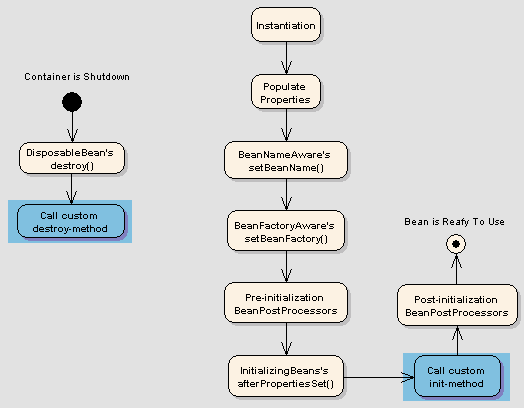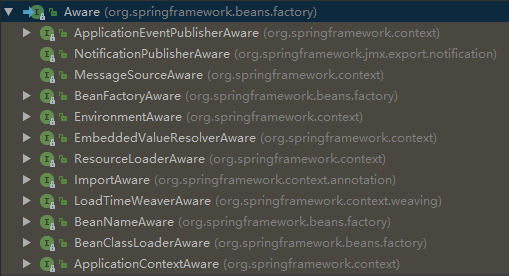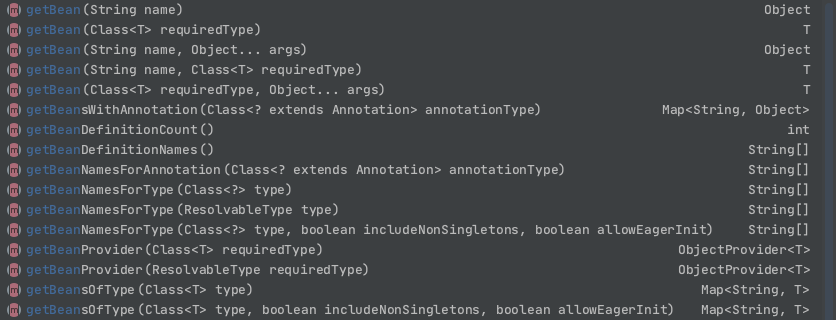Spring Bean 生命周期与作用域总结
Bean 的生命周期
Spring Bean Factory 负责管理 bean 的生命周期,可以分为三个阶段:

一、初始化阶段:
- Instantiation:Spring 启动,查找并加载需要被 Spring 管理的bean,进行 Bean 的实例化,调用构造方法。
- Populate Properties:属性注入,包括引用的 Bean 和值,调用 setter 方法。
- 调用该 Bean 实现的各种生命周期回调接口。
二、就绪阶段:
- 此时,Bean 已经准备就绪,可以被应用程序使用了。它们将一直驻留在应用上下文中,直到应用上下文被销毁。
三、销毁阶段:
- 调用该 Bean 实现的各种生命周期回调接口。
ApplicationContextInitializer
Callback interface for initializing a Spring
ConfigurableApplicationContextprior to being refreshed.Typically used within web applications that require some programmatic initialization of the application context. For example, registering property sources or activating profiles against the context’s environment.
初始化和销毁方法
Spring 框架提供了以下几种方式指定 bean 生命周期的初始化和销毁回调方法:
| 初始化 | 销毁 | |
|---|---|---|
| 实现 Spring Boot 的接口 | ApplicationRunner |
|
| 实现 Spring Framework 的接口 | InitializingBean |
DisposableBean |
在 Spring @Bean 注解中指定属性 |
@Bean(initMethod="xxx") |
@Bean(destroyMethod="xxx") |
| 在 Spring bean 配置文件指定属性 | <bean init-method="xxx" /> |
<bean destroy-method="xxx" /> |
使用 JavaEE 规范 javax.annotation 包中提供的注解 |
@PostConstruct |
@PreDestroy |
在 Spring 容器启动后执行一些初始化逻辑是一个很常见的场景,注意使用不同的方式,顺序不同:

参考:https://zhuanlan.zhihu.com/p/44786291
例子:
1 |
|
Aware 接口
在日常的开发中,我们经常需要用到 Spring 容器本身的功能资源,可以通过 Spring 提供的一系列 Aware (org.springframework.beans.factory) 子接口来实现具体的功能。Aware 是一个具有标识作用的超级接口,实现该接口的 bean 具有被 Spring 容器通知的能力,而被通知的方式就是通过回调,以依赖注入的方式为 bean 设置相应属性,这是一个典型的依赖注入的使用场景。Aware 接口的继承关系如下:

这些 *Aware 子接口在 Spring Bean 的生命周期中被回调的顺序如下:
BeanNameAware (org.springframework.beans.factory)BeanClassLoaderAware (org.springframework.beans.factory)BeanFactoryAware (org.springframework.beans.factory)EnvironmentAware (org.springframework.context)EmbeddedValueResolverAware (org.springframework.context)ResourceLoaderAware (org.springframework.context)ApplicationEventPublisherAware (org.springframework.context)MessageSourceAware (org.springframework.context)ApplicationContextAware (org.springframework.context)

例子
通过 ApplicationContextAware 注入 ApplicationContext,用以主动获取 Bean:

1 |
|
Bean 的作用域
使用 @Scope 注解定义 bean 的作用域,它可以与 @Component 或 @Bean 一起使用:
单例(Singleton):在整个应用中,只创建bean的一个实例。
原型(Prototype):每次注入或者通过Spring应用上下文获取的时候,都会创建一个新的bean实例。注意,此时目标 bean 要使用代理模式,否则无法达到效果:
1
2
3
4
5// 目标 bean 为类
@Scope(value = ConfigurableBeanFactory.SCOPE_PROTOTYPE, proxyMode = ScopedProxyMode.TARGET_CLASS)
// 目标 bean 为接口
@Scope(value = ConfigurableBeanFactory.SCOPE_PROTOTYPE, proxyMode = ScopedProxyMode.INTERFACES)会话(Session):在Web应用中,为每个会话创建一个bean实例。
请求(Rquest):在Web应用中,为每个请求创建一个bean实例。
参考
org.springframework.beans.factory.Aware